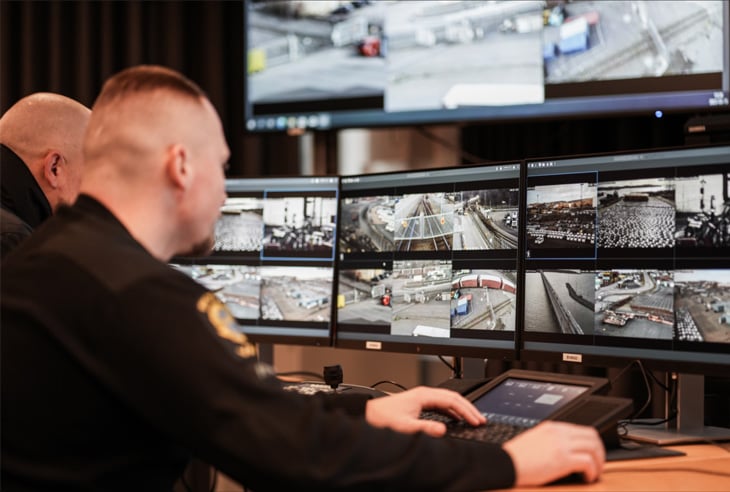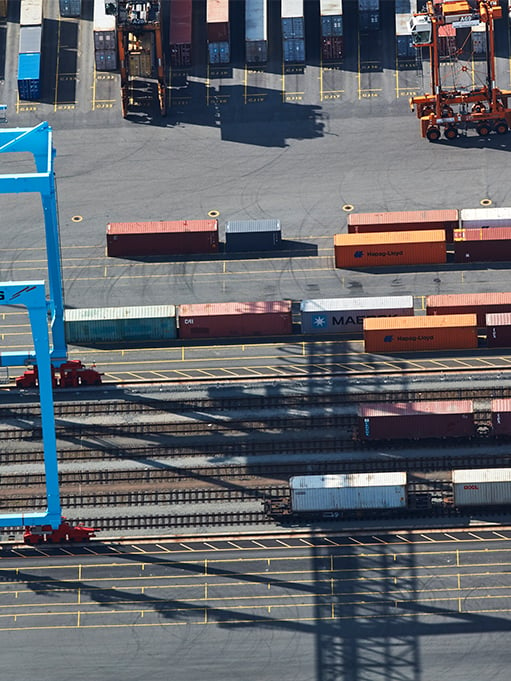38
In 2022, 38 security drills were carried out in the port area together with terminal operators.
38
In 2022, 38 security drills were carried out in the port area together with terminal operators.
0%
In 2022, 38 security drills were carried out in the port area together with terminal operators.
0%
In 2022, 38 security drills were carried out in the port area together with terminal operators.
Security is a priority issue.
Security is a priority issue for the Gothenburg Port Authority. Cargo of enormous value is handled at the port, and it is of strategic importance for society. To protect ports as a whole, and not just quayside areas, the EU has adopted Directive 2005/65/EC on enhancing port security.
The port works systematically on security and conducts continuous reviews of its security protection. There has been a focus on this during the year, and as a consequence of Russia’s invasion of Ukraine, an additional review of security work was undertaken. The war in Ukraine has brought about a change in how security work is viewed. The level has been heightened in selected areas, and contact channels have also been reviewed and updated. The port has also carried out two port security drills and 38 security drills together with terminal operators, and set up a backup control centre that can take charge of security work in the port if required.

Port Security.
The EU’s rules on port security apply for all ports where there are port facilities that are subject to the rules for maritime security. The intention is that the entire port area shall be covered by one security system.
Port security involves, among other things, the conducting of a port security investigation, on the basis of which security plans must be drawn up.
There are three security levels, and every port must have a Port Facility Security Officer.
Level 1 – Normal level, where operations proceed as normal.
Level 2 – Heightened security, where ID checks and random checks will be performed within the port security area.
Level 3 – Restricted access to the port security area, where only authorised persons have the right of access. Checks will be performed to a wider extent. Companies with operations inside the area must draw up lists of employees, visitors and vehicles that apply for access. These must be identified before access is granted. No other access is permitted, nor to the Torsviken bird sanctuary or other areas in between.
Terrorist attacks on ports can result in serious disruption in transport systems and/or harm people and industrial operations in the port and nearby areas.
Photography and filming.
The following terminals are subject to the Swedish Installations Protections Act (2010:305) and a ban on photographs, filming, depictions, descriptions or measurements of or within the protected object.
- APM Terminals
- Gothenburg Ro/Ro Terminal
- Logent Ports & Terminals
- Skarvik/Rya, Energy Port, Gothenburg Port Authority
- Torshamnen, Energy Port, Gothenburg Port Authority
Anyone who intentionally or through negligence is in breach of a ban on producing depictions, descriptions or measurements may be convicted of the illegal depiction of a protected object and issued with a fine or sentenced to imprisonment for a maximum of one year.
Rules:
- All filming and photography of the Protected Object is prohibited unless a permit has been applied for and issued by each terminal’s Port Facility Security Officer (PFSO).
- It is permitted to film and take photographs in the vicinity of the protected object if the protected object itself is not depicted.
- The protected object is clearly designated by signs on the fence.
Rules of access.
All terminals at the Port of Gothenburg that are ISPS-classified have one hundred percent access control. Certain terminals are also classified as facilities of importance to society and protected objects under the Swedish Installations Protection Act.
This strengthens the requirement for access, and the Act gives appointed security guards extended authority to act within and beside the protected object (as a supplement to maritime security and port security legislation).
Everyone who works within those parts of the Port of Gothenburg that have ISPS and protected object classification must have a site access card or be correctly pre-registered with the port facility. Those working within the port facility who hold a site access card must wear it so that it is visible. Everyone must be able to present valid photo ID upon request. Random checks on site access cards and ID documents are performed regularly.
All persons who are in the port facilities must observe the rules on order and traffic that apply within the Port of Gothenburg’s area.
The Port of Gothenburg and its terminals perform background checks on persons who hold or apply for a site access card to protected objects. The Port of Gothenburg has the right to perform background checks on all persons who apply for access to protected objects.
If you are going to visit the port area, you must pass through Port Entry, the joint point of entry to the port area. Read more here Read more here.

Dangerous goods.
With regard to dangerous goods, it is important to minimise the risk of theft or unauthorised procedures in connection with land transport. The handling of dangerous goods is regulated in the European regulations ADR-S and RID-S.
There are also security provisions in the International Maritime Dangerous Goods Code (IMDG Code). This states that all land-based shipping company personnel, all vessel-based personnel and all port personnel who are involved in the transportation of dangerous goods must be aware of the security provisions for such goods, in addition to the provisions laid down in the ISPS Code.
Ports are affected because the areas for interim storage and parking places for vehicles must be properly protected, well-lit and as far as possible not accessible for the general public. When dangerous goods are collected in the port, they may only be handed over to transport service providers whose identity has been confirmed in an appropriate manner.
CONTACT
Port Security
+46 31 368 75 00
portsecurity@portgot.se
CONTACT
Port Security
+46 31 368 75 00
portsecurity@portgot.se
0%
Port Security
+46 31 368 75 00
portsecurity@portgot.se
0%
Port Security
+46 31 368 75 00
portsecurity@portgot.se